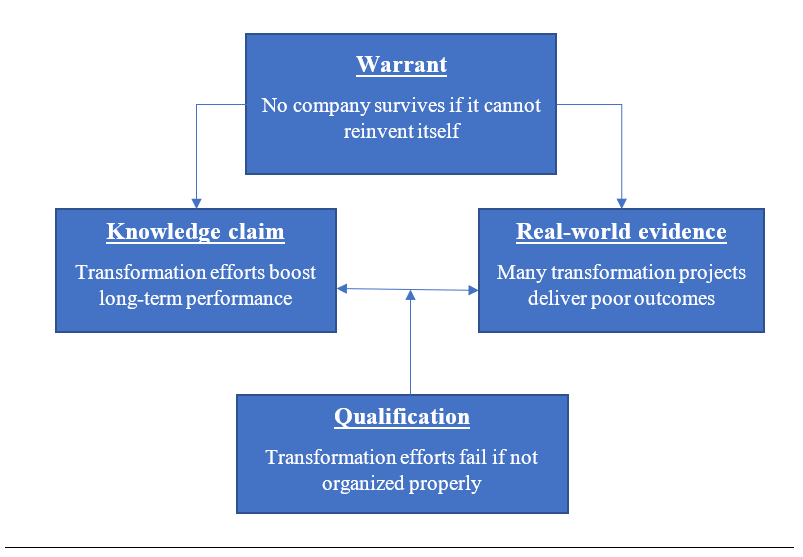Leading the Transformation Programme
“The only true voyage of discovery, the only fountain of Eternal
youth, would be not to visit strange lands but to possess other
eyes, to behold the universe through the eyes of another.”
- Marcel Proust
The world of transformation management has evolved significantly. Though today’s leaders use artificial intelligence techniques to predict outcomes, transformation remains challenging and unruly. Kotter (2006) says, “Most major change initiatives – whether intended to boost quality, improve culture, or reverse a corporate death spiral – generate only lukewarm results. Many fail miserably” (p. 1). Preventing transformation management failure has become increasingly critical.
Leaders equipped with advanced change management techniques are more likely to move ahead confidently, acting with less hesitation and delivering successful transformation results. Recent developments in both academic and empirical fields illustrate that formal methods and techniques are usually designed rationally and grounded in the ‘triple constraint’: time, price and scope -- the most significant variables. Such methods and techniques, however, cannot deal with irrationality of human behaviour, human heuristics and biases.
When organizations are successful, employees tend to be status-quo biased, firmly sticking to the inertia of their success. Petroski (1985) echoes this thought: “with each tottering attempt to walk, our bodies learn from falls what not to do next time. In time we walk without thinking and think without falling, but it is not so much that we have learned to walk as we learned not to fall” (p. 16).
For instance, if we zoom into transformation classics, such as Kotter’s article ‘Leading Change: Why Transformation Efforts Fail’ (2006), we discover that his approach is too rational. Kotter confidently asserts, “To give your transformation effort the best chance of succeeding, take the right actions at each stage – and avoid common pitfalls.” (p. 2). Kotter’s masterpiece is built on eight stages:
Establish a sense of urgency
Form a powerful guiding coalition
Create a vision
Communicate the vision
Empower others to act on the vision
Plan for and create short-term wins
Consolidate improvements and produce more change
Institutionalize new approaches
Toulmin’s structure of argumentation (Toulmin, 2003) helps us explore Kotter’s well-known transformation techniques. Toulmin’s structure connects warrant, knowledge claim, real-world evidence and qualification, a set of lenses to test the rationality of a phenomenon. Figure 1 represents a visual representation of argumentation.
Figure 1
Summary of Kotter’s transformation techniques
Source: Adapted from Toulmin’s structure of argumentation (Toulmin, 2003)
In the following table we connect 1) Kotter’s change management techniques 2) real-world empirical evidence and 3) a critique of Kotter’s approach.
Table 1
Analyzing Kotter’s change management techniques
Yet it is not always clear why transformation efforts fail. When studying transformation failures, scholars and practitioners can easily fall victim to correlations rather than discovering true cause and effect relationships. Obviously, Kotter (2006) illustrates the importance of predetermined programme milestones and phases. In his opinion, each milestone plays a significant role when leading transformation programmes. Each phase is equally important and contributes to transformation success. Further, he describes pitfalls that may exist in many -- even the best -- transformation programmes.
In our opinion, Kotter (2006) observes and explains correlations between particular project phases, as well as project successes and failures, but he does not successfully address root causes. In fact, the root-cause of the transformation failures is human heuristic and bias (Flyvbjerg et al., 2018; Flyvbjerg, 2006, 2017; Kahneman, 2012; Kahneman and Tversky, 1979; Taleb 2010).
Indeed, Kotter’s transformation techniques (Kotter, 2006) omits the most fundamental difficulties transformation programmes face: the need to understand irrational human behavior, heuristic and bias. Addressing those phenomena is critical to the success of transformation programmes.
References
Flyvbjerg B. (2006). From Nobel Prize to Project Management: Getting Risk Right. Project Management Journal, 37 (3), 5–15.
Flyvbjerg, B. (2017) (ed.), The Oxford Handbook of Megaproject Management, Oxford: Oxford University Press.
Flyvbjerg B., Ansar, A., Budzier, A., Buhl, S., Cantarelli, C., Garbuio, M., Glenting, C., Skamris Holm, M., Lovallo, D., Lunn, D., Molin, E., Rønnest, A., Stewart, A. and van Wee, B. (2018) “Five Things You Should Know about Cost Overrun”, Transport Research Part A: Policy and Practice, 118: pp. 174-190.
Kahneman D., Tversky, A. (1979). Intuitive prediction: Biases and corrective procedures. In Makridakis, S., Wheelwright, S.C., eds., Studies in the management sciences: Forecasting, vol. 12. Amsterdam: North Holland, pp. 313–327.
Kahneman D. Thinking, Fast and Slow (Great Britain: Penguin Books, 2012).
Kotter J. (2006) ‘Leading Change: Why Transformation Efforts Fail’, Harvard Business Review.
Taleb N. (2010) The Black Swan: The Impact of the Highly Improbable, 2nd ed., New York: Random House.
Toulmin S. E. (2003) The Uses of Argument., Cambridge University Press; Updated edition.







